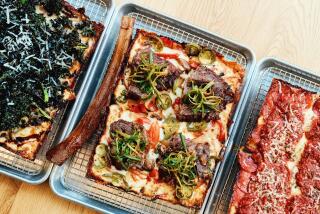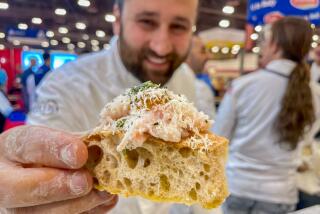How Sweet Was My Pizza
- Share via
In Italy, Easter is the most important holiday of the year. It follows Lent, a 40-day period that used to be marked by fasting and abstinence from meat, and though Lent is no longer observed with much strictness, Easter remains the prime occasion for feasting and celebration.
Pasqua, Italian for Easter, derives from Pesach (passage) , the Hebrew name of Passover, and along with their respective religious significance, both feasts are intimately bound to the passing of the seasons.
Many traditional Italian Easter foods center around grains. There are numerous pizze and torte, some of which contain cooked wheat berries or rice--the grains symbolizing the rebirth of the earth in the spring. Most notable among these is the Pastiera Napoletana, a pie with a crust made from the sweet pastry dough called Pasta Frolla and a filling of sweetened ricotta bound with eggs, a cooked custard cream and cooked hulled wheat berries.
Though the addition of the wheat may seem bizarre to American palates, it adds a subtle, nut-like flavor to the filling; it was most likely originally intended as an inexpensive way to stretch the filling.
Grano, the wheat berries essential to the pastiera, are widely available in Italian-American grocery stores during the Easter season. If you find whole-wheat grains impossible to obtain, substitute the same amount of raw rice in the recipe and cook for only about 20 minutes.
Another traditional Easter specialty widely seen throughout Italy is Pizza Rustica. In Italian pastry terms, those items referred to as rustica (country-style) are savory pastries. The standard southern Italian versions of Pizza Rustica have a crust made from Pasta Frolla, the same sweet pastry used for the pastiera. Though the combination may seem strange, I encourage you to try it--the sweetness of the crust tempers the somewhat salty filling.
Pizza Rustica usually appears among the antipasti on Easter Sunday, though it also makes a perfect brunch or lunch dish throughout the year.
Another often-seen Italian Easter pastry is pizza dolce di ricotta, sometimes referred to as Italian cheesecake; it’s a Pasta Frolla crust filled with sweetened ricotta perfumed with cinnamon and anisette. Light and not excessively sweet, it exists in hundreds of versions, where grated lemon or orange zest, chopped chocolate, toasted almonds or mixed candied fruits allow the flavor of the ricotta to come through.
The basis for all of these pastries is Pasta Frolla, which is simple to prepare in the food processor or by hand. The dough handles easily and is very forgiving--it doesn’t suffer from any of the ills that temperamental flaky pastries do, and the dough doesn’t soften excessively during rolling and handling. A fairly low quantity of butter makes the dough easier to work with, and the eggs and sugar contribute a tenderness that helps the dough tolerate a bit of overhandling. If you have scraps of Pasta Frolla left over, knead them into an extra batch of dough for the Biscotti recipe--which was, in fact, originally intended to make use of the scraps.
All these traditional Italian Easter pastries will keep well for several days before serving if tightly wrapped in plastic wrap and refrigerated after they are baked and cooled, so that you may enjoy a buona Pasqua free of last-minute preparations.
Throughout Italy, pastry dough means Pasta Frolla. A tender (frolla means friable) sweet pastry, Pasta Frolla is easy to make in the food processor. The baking powder makes the dough lighter and helps ensure a well-baked bottom crust.
PASTA FROLLA
2 cups flour
1/3 cup sugar
1/4 teaspoon salt
1/2 teaspoon baking powder
1/2 cup cold unsalted butter, cut into 8 pieces
2 large eggs
Combine flour, sugar, salt and baking powder in bowl of food processor and pulse several times to mix. Evenly distribute butter over mixture. Pulse until very finely powdered, about 10 times at 1-second intervals. Add eggs and continue to pulse until dough forms ball that revolves on blade.
Remove dough from bowl and press into disc. Wrap and chill until needed. Dough may be refrigerated up to 3 days or frozen. Defrost frozen dough in refrigerator overnight before using. Use as directed in recipes.
Note: To mix dough by hand, combine flour, sugar, salt and baking powder in mixing bowl and stir well to mix. Rub in butter finely with fingertips until mixture is mealy but still cool and powdery. Stir in eggs with fork and continue stirring until dough holds together. Scrape dough from bowl to lightly floured work surface. Press and knead dough together, folding it over on itself several times. Wrap and chill until needed.
Pastiera is the ultimate Neapolitan pastry. Seen in all the pastry shops in Naples, it is also very popular in Rome and throughout southern Italy.
PASTIERA NAPOLETANA
Pasta Frolla
Wheat and Ricotta Filling
1/2 teaspoon ground cinnamon
1 egg, beaten with dash salt
Butter 9-inch cake pan, 2 inches deep. To assemble, cut off 1/3 of Pasta Frolla and set aside. Roll remaining 2/3 of dough into 14-inch disk and ease into prepared pan. Allow dough to hang over edge of pan. Spoon in Wheat and Ricotta Filling. Sprinkle with cinnamon.
Roll remaining 1/3 of dough into 10-inch square. Cut into 10 (1-inch wide) strips. Moisten strips with egg. Moisten rim of dough on pan with beaten egg and arrange 5 strips in each direction, forming diagonal lattice. Trim excess dough and push dough off top rim of pan so it is completely within pan.
Bake on bottom rack set at lowest level at 350 degrees about 45 minutes, until filling is set and pastry is light golden. Cool in pan before unmolding. To unmold, invert onto flat plate. Lift off pan. Replace pan with another plate or platter and invert so pastiera is right side up. Serve at room temperature. Makes about 10 servings.
Each serving contains about:
379 calories; 317 mg sodium; 169 mg cholesterol; 18 grams fat; 45 grams carbohydrates; 11 grams protein; 0.31 gram fiber; 42% calories from fat.
Wheat and Ricotta Filling
1/2 cup hulled wheat kernels
1/2 teaspoon salt
1 tablespoon butter
3 tablespoons plus 1/4 cup sugar
2 tablespoons flour
1/2 cup milk
3 eggs
1 teaspoon vanilla
1 cup whole-milk ricotta cheese
1/2 teaspoon orange flower water
1/2 cup diced candied orange peel
Soak wheat kernels in water to cover, overnight if possible. Drain. Place in pan and cover with 3 or 4 inches water. Add salt and butter and simmer until tender, about 2 hours. Add water as necessary to keep from drying out. Cool and refrigerate until needed.
Combine 3 tablespoons sugar and flour in small, non-reactive saucepan. Stir well to mix. Slowly whisk in milk. Whisk in 1 egg. Cook over low heat, stirring constantly, until mixture thickens and comes to boil. Boil, stirring vigorously, about 1/2 minute. Remove from heat. Stir in vanilla. Scrape mixture into clean bowl. Press plastic wrap against surface and chill.
When cool, place in mixing bowl and stir with ricotta to make smooth, creamy mixture. Stir in remaining 1/4 cup sugar, remaining 2 eggs, orange flower water and candied orange peel.
This most typical savory pie is served at Carnevale (the day before Ash Wednesday) and then again at Easter. Though many recipes for Pizza Rustica specify that the dried sausage, mozzarella and other filling ingredients be layered, in the Neapolitan version they are diced and added to the ricotta filling, making the pizza easier to cut into wedges.
PIZZA RUSTICA ALLA NAPOLETANA
1 pound whole-milk ricotta cheese
3 large eggs
1 teaspoon freshly ground black pepper
1/4 cup grated Pecorino Romano cheese
1/2 pound fresh mozzarella cheese, coarsely shredded
1/4 pound sweet dried sausage, peeled and diced
1/4 pound prosciutto, shredded
1/4 cup chopped flat-leaf parsley
Pasta Frolla
1 egg, beaten with dash salt
Place ricotta cheese in mixing bowl and stir in eggs, 1 at time, to make smooth, creamy mixture. Stir in pepper, cheeses, sausage, prosciutto and parsley.
Butter 9-inch cake pan, 2 inches deep. Cut off 1/3 of Pasta Frolla and set aside. Roll remaining 2/3 of dough into 14-inch disk and ease into prepared pan. Allow dough to hang over edge of pan. Spoon in ricotta filling and spread evenly.
Roll remaining 1/3 of dough into 10-inch square. Cut into 10 (1-inch wide) strips. Moisten strips with beaten egg. Moisten rim of dough on pan with egg and arrange 5 strips in each direction, forming diagonal lattice. Trim excess dough even with top of pan and push dough off top rim so it is completely within pan.
Bake on bottom rack set at lowest level at 350 degrees about 45 minutes, until filling is set and pastry is light golden. Cool in pan before unmolding. To unmold, invert onto flat plate. Lift off pan. Replace pan with another plate or platter and invert so pizza is right side up. Serve at room temperature. Makes about 10 servings.
Each serving contains about:
491 calories; 806 mg sodium; 213 mg cholesterol; 30 grams fat; 29 grams carbohydrates; 25 grams protein; 0.08 gram fiber; 55% calories from fat.
This most typical Italian dessert is often served as an Easter specialty in southern Italy. The flavorings vary slightly according to the region; toasted slivered almonds, chopped chocolate and grated lemon and orange zest are sometimes included.
PIZZA DOLCE DI RICOTTA
1 1/2 pounds ricotta cheese
1/2 cup sugar
4 eggs
1 teaspoon vanilla
1 tablespoon anisette
3 tablespoons chopped candied citron or orange peel
1 teaspoon ground cinnamon
Pasta Frolla
1 egg, beaten with dash salt
Place ricotta cheese in mixing bowl and stir in sugar. Stir in eggs, 1 at time, to make smooth, creamy mixture. Stir in vanilla, anisette, citron and 1/2 teaspoon cinnamon.
Butter 9-inch cake pan, 2 inches deep. To assemble, cut off 1/3 of Pasta Frolla and set aside. Roll remaining 2/3 of dough into 14-inch disk and ease into prepared pan. Allow dough to hang over edge of pan. Spoon in ricotta filling and spread evenly. Sprinkle filling with remaining 1/2 teaspoon cinnamon.
Roll remaining 1/3 of dough into 10-inch square. Cut into 10 (1-inch wide) strips. Moisten strips with egg wash. Moisten rim of dough on pan with egg wash and arrange 5 strips in each direction, forming diagonal lattice. Trim excess dough even with top of pan and push dough off top rim so it is completely within pan.
Bake on bottom rack set at lowest level at 350 degrees about 45 minutes, until filling is set and pastry is light golden. Cool in pan before unmolding. To unmold, invert onto flat plate. Lift off pan. Replace pan with another plate or platter and invert so pizza is right side up. Serve at room temperature. Makes about 10 servings.
Each serving contains about:
394 calories; 243 mg sodium; 194 mg cholesterol; 18 grams fat; 42 grams carbohydrates; 15 grams protein; 0.10 gram fiber; 42% calories from fat.
More to Read
Eat your way across L.A.
Get our weekly Tasting Notes newsletter for reviews, news and more.
You may occasionally receive promotional content from the Los Angeles Times.










